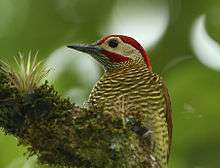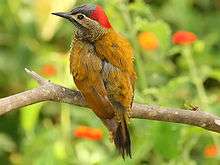Golden-olive woodpecker
The golden-olive woodpecker (Colaptes rubiginosus) is a resident breeding bird from Mexico south and east to Guyana, northwest Argentina, Trinidad and Tobago. It was formerly placed in the genus Piculus.[4] The scientific name rubiginosus means "full of rust", describing the color of the bird's wings and back.
| Golden-olive woodpecker | |
|---|---|
 | |
| Male, CATIE, Turrialba, Costa Rica | |
| Scientific classification | |
| Kingdom: | Animalia |
| Phylum: | Chordata |
| Class: | Aves |
| Order: | Piciformes |
| Family: | Picidae |
| Genus: | Colaptes |
| Species: | C. rubiginosus |
| Binomial name | |
| Colaptes rubiginosus | |
| Synonyms[2][3] | |
| |
Description

The golden-olive woodpecker is 22 cm (8.7 in) long and weighs 68 g (2.4 oz). Adults are mainly golden olive above with some barring on the tail. The forecrown is grey and the hindcrown red. The face is yellow-white and the underparts are barred black and yellowish. The bill is black. Adult males have a red moustachial strip which is lacking in the female.
Habitat and ecology
The habitat of this woodpecker is forests, more open woodlands and cultivation. It is most common in the mountains. Two or three white eggs are laid in a nest hole in a tree and incubated by both sexes. The young are fed by regurgitation.
Due to its habitat-mainly montane forests, separated by large rivers-it has evolved into about 20 subspecies. P. r. tobagensis from Tobago is larger and heavier-billed than P. r. trinitatis from Trinidad. Some of the South American subspecies have only very narrow yellow barring on the underparts and the Andean subspecies show a pale eye ring.
Golden-olive woodpeckers mainly eat insects, including ants and beetle larvae, with some fruit and berries. The call of this bird is a loud wheep.
References
- BirdLife International (2014). "Colaptes rubiginosus". IUCN Red List of Threatened Species. 2014. Retrieved 6 March 2016.CS1 maint: ref=harv (link)
- Handbook of the Birds of the World. vol. 7. 2002.
- "Piculus aeruginosus". Avibase.
- Benz, Brett W.; Robbins, Mark B.; Peterson, A. Townsend (2006). "Evolutionary history of woodpeckers and allies (Aves: Picidae): Placing key taxa on the phylogenetic tree". Molecular Phylogenetics and Evolution. 40: 389–399. doi:10.1016/j.ympev.2006.02.021. PMID 16635580.CS1 maint: ref=harv (link)
- ffrench, Richard; O'Neill, John Patton; Eckelberry, Don R. (2003). A Guide to the Birds of Trinidad and Tobago. London: Christopher Helm. ISBN 0-7136-6759-1.
- Hilty, Steven L. (2003). Birds of Venezuela. London: Christopher Helm. ISBN 0-7136-6418-5.
External links
| Wikimedia Commons has media related to Colaptes rubiginosus. |
| Wikispecies has information related to Colaptes rubiginosus |
- Golden-olive woodpecker stamps from El Salvador, Nicaragua and Trinidad and Tobago at bird-stamps.org
- BirdLife species factsheet for Colaptes rubiginosus
- "Golden-olive woodpecker media". Internet Bird Collection.
- Golden-olive woodpecker species account at Neotropical Birds (Cornell Lab of Ornithology)
- Interactive range map of Colaptes rubiginosus at IUCN Red List maps
- Audio recordings of Golden-olive woodpecker on Xeno-canto.
- Colaptes rubiginosus in the Flickr: Field Guide Birds of the World
